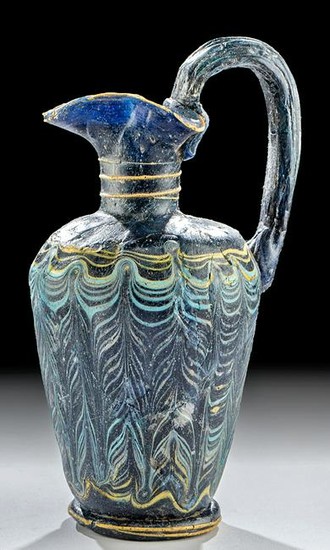Greek Core Form Glass Trefoil Spouted Oinochoe
Ancient Greece, eastern Mediterranean, probably from Rhodes, ca. early 5th century BCE. A very large and quite striking core-formed glass oinochoe vessel with an ample body, a tubular neck rising to a trefoil spout, and a high curved, thick trailed handle in rich deep blue hues with contrasting tangerine orange threads lining the rim and base as well as wrapped around the neck and adorning the body, and tangerine orange and sky blue zigzagged swags throughout the body. Dark cobalt blue was favored by the ancients in part because it reminded them of precious lapis lazuli. A beautiful vessel like this would have been made for the elites of ancient society. Size: 3.25" W (handle to opposite side) x 5.75" H (8.3 cm x 14.6 cm)
According to the Corning Museum of Glass online dictionary, core forming is "the technique of forming a vessel by winding or gathering molten glass around a core supported by a rod. After forming, the object is removed from the rod and annealed. After annealing, the core is removed by scraping." This process of glass making was begun in the late 16th century BCE by glassmakers of Mesopotamia, and then adopted by Egyptian glassmakers in the 15th century BCE. The technique almost came to an end in the so-called Dark Ages of Mediterranean civilization (1200 to 900 BCE); however, by the 9th century BCE a new generation of glassmakers took up the technique once again, and between the 6th and 4th century BCE core-forming spread throughout the Mediterranean.
See similar examples from Camiros, Rhodes in the British Museum, published in D. B. Harden, "Catalogue of Greek and Roman Glass in the British Museum," Volume I, "Core and Rod-Formed Vessels and Pendants and Mycenean Cast Objects" (London 1981), p. 98, nos. 258-61.
Provenance: private East Coast, USA collection; ex-Dr. Klaus Morkramer collection, Germany, acquired in the 1990s
All items legal to buy/sell under U.S. Statute covering cultural patrimony Code 2600, CHAPTER 14, and are guaranteed to be as described or your money back.
A Certificate of Authenticity will accompany all winning bids.
We ship worldwide to most countries and handle all shipping in-house for your convenience.
#152842 Dimensions: Condition Report: Surface shows expected weathering. Repaired from several large pieces with a few minute nicks near break lines and some resurfacing. Minor losses to trailing around the trefoil spout and base as shown.
View it on
Estimate
Time, Location
Auction House
Ancient Greece, eastern Mediterranean, probably from Rhodes, ca. early 5th century BCE. A very large and quite striking core-formed glass oinochoe vessel with an ample body, a tubular neck rising to a trefoil spout, and a high curved, thick trailed handle in rich deep blue hues with contrasting tangerine orange threads lining the rim and base as well as wrapped around the neck and adorning the body, and tangerine orange and sky blue zigzagged swags throughout the body. Dark cobalt blue was favored by the ancients in part because it reminded them of precious lapis lazuli. A beautiful vessel like this would have been made for the elites of ancient society. Size: 3.25" W (handle to opposite side) x 5.75" H (8.3 cm x 14.6 cm)
According to the Corning Museum of Glass online dictionary, core forming is "the technique of forming a vessel by winding or gathering molten glass around a core supported by a rod. After forming, the object is removed from the rod and annealed. After annealing, the core is removed by scraping." This process of glass making was begun in the late 16th century BCE by glassmakers of Mesopotamia, and then adopted by Egyptian glassmakers in the 15th century BCE. The technique almost came to an end in the so-called Dark Ages of Mediterranean civilization (1200 to 900 BCE); however, by the 9th century BCE a new generation of glassmakers took up the technique once again, and between the 6th and 4th century BCE core-forming spread throughout the Mediterranean.
See similar examples from Camiros, Rhodes in the British Museum, published in D. B. Harden, "Catalogue of Greek and Roman Glass in the British Museum," Volume I, "Core and Rod-Formed Vessels and Pendants and Mycenean Cast Objects" (London 1981), p. 98, nos. 258-61.
Provenance: private East Coast, USA collection; ex-Dr. Klaus Morkramer collection, Germany, acquired in the 1990s
All items legal to buy/sell under U.S. Statute covering cultural patrimony Code 2600, CHAPTER 14, and are guaranteed to be as described or your money back.
A Certificate of Authenticity will accompany all winning bids.
We ship worldwide to most countries and handle all shipping in-house for your convenience.
#152842 Dimensions: Condition Report: Surface shows expected weathering. Repaired from several large pieces with a few minute nicks near break lines and some resurfacing. Minor losses to trailing around the trefoil spout and base as shown.



